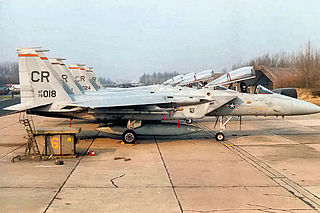
The 50th Space Wing is a wing of the United States Air Force under the major command of Air Force Space Command. It was activated on 30 January 1992, replacing the 2nd Space Wing, which was inactivated on the same date.

The 527th Space Aggressor Squadron is a non-flying United States Air Force unit assigned to the 57th Adversary Tactics Group. The 527 SAS is stationed at Schriever Air Force Base, Colorado, being a Geographically Separated Unit (GSU) of the 57 ATG, which is stationed at Nellis AFB, Nevada.

Quartier La Horie is a French Army base. It is located in the Moselle département, about 2 miles(3 km) west of the town of Phalsbourg, on the north side of the Route nationale 4 (N4) Highway adjacent to the village Saint-Jean-Kourtzerode; 29 miles (47 km) northwest of Strasbourg.

The United States Air Force's 36th Wing is the host wing for Andersen Air Force Base, Guam. It is part of Pacific Air Forces' Eleventh Air Force. The 36th Wing provides day-to-day mission support to more than 9,000 military, civilian, dependent and retired personnel and 15 associate units on the base.

The 366th Fighter Wing is a fighter wing of the United States Air Force Air Combat Command stationed at Mountain Home Air Force Base, Idaho.

Seventeenth Expeditionary Air Force is a numbered air force of the United States Air Force located at Ramstein Air Base, Germany. The command served the United States Air Forces in Europe during (1953–1996) and United States Air Forces Africa during 2008-2012. Upon reactivation on 1 October 2008, it became the air and space component of United States Africa Command. In this capacity, Seventeenth Air Force was referred to as U.S. Air Forces Africa (AFAFRICA). 17 AF was reformed in April 2012 to become the 17th Expeditionary Air Force, sharing a commander and headquarters with the Third Air Force.

The 104th Fighter Wing is a unit of the Massachusetts Air National Guard, stationed at Westfield-Barnes Regional Airport, Westfield, Massachusetts. When activated to federal service, the Wing is gained by the United States Air Force Air Combat Command.

The 52d Fighter Wing is a wing of the United States Air Force stationed at Spangdahlem Air Base, Germany. It was activated in 1948, but derives significant elements of its history from the predecessor Second World War 52d Fighter Group, which is now the 52d Operations Group, subordinate to the wing.

The 9th Attack Squadron in a United States Air Force squadron, assigned to the 49th Operations Group, stationed at Holloman Air Force Base, New Mexico. The squadron is a training unit for new pilots and sensor operators for the MQ-9 Reaper Remotely Piloted Aircraft (RPA).

The 23d Fighter Squadron is an inactive United States Air Force unit. It was last assigned to the 52d Operations Group and stationed at Spangdahlem Air Base, Germany. It was inactivated on 13 August 2010.

The 131st Fighter Squadron is a unit of the Massachusetts Air National Guard 104th Fighter Wing located at Barnes Air National Guard Base, Westfield, Massachusetts. The 131st is equipped with the F-15C/D Eagle.

The 53d Fighter Squadron is an inactive United States Air Force unit. It was last assigned to the 52d Operations Group and stationed at Spangdahlem Air Base, Germany. It was inactivated on 31 March 1999.

The 81st Fighter Squadron is a flying squadron of the United States Air Force. It is Geographically Separated Unit of the 14th Flying Training Wing at Columbus Air Force Base, Mississippi, and operates the A-29 Super Tucano aircraft conducting close air support training to the Afghan Air Force as part of ISAF. It is stationed at Moody Air Force Base, Georgia.

The 7th Fighter Squadron is an inactive United States Air Force unit, last assigned to the 49th Operations Group. It was last stationed at Holloman Air Force Base, New Mexico. On 2 May 2014, the 7th Fighter Squadron was inactivated.

The 525th Fighter Squadron is a United States Air Force unit. It is assigned to the 3d Operations Group at Elmendorf Air Force Base, Alaska. The squadron was first activated as the 309th Bombardment Squadron in February 1942. After training in the United States, it deployed to the Mediterranean Theater of Operations, where it became the 525th Fighter-Bomber Squadron and engaged in combat until the spring of 1945, earning two Distinguished Unit Citations. After VE Day, the squadron became part of the occupation forces in Germany. Briefly inactivated in 1946, it returned to Germany a few months later.

The 32d Air Operations Squadron is an inactive United States Air Force unit. Its last assignment was with 32d Air Operations Group, based at Ramstein Air Base, Germany. It was inactivated on 1 November 2005.

The 388th Operations Group is the flying component of the 388th Fighter Wing, assigned to the Air Combat Command Twelfth Air Force. The group is stationed at Hill Air Force Base, Utah.

The 36th Operations Group is the operational component of the 36th Wing, assigned to the United States Air Force Pacific Air Forces. The group is stationed at Andersen Air Force Base, Guam.

The 480th Fighter Squadron is an active United States Air Force unit. It is assigned to the 52d Operations Group, stationed at Spangdahlem Air Base, Germany. It was reactivated on 13 August 2010.











































